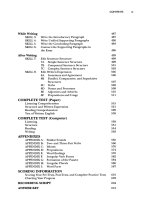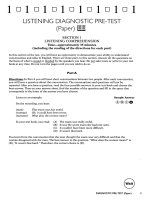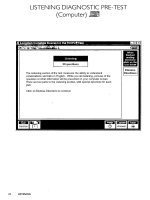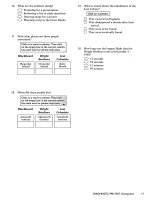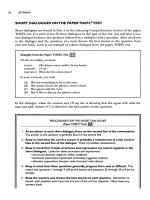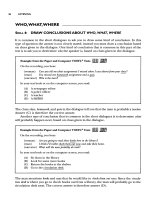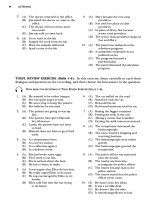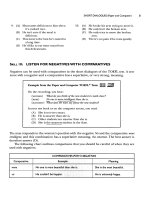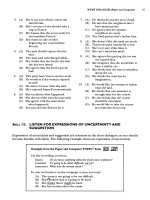LONGMAN PREPARATION COURSE FOR THE TOEFL IBT TEST, 3e
Bạn đang xem bản rút gọn của tài liệu. Xem và tải ngay bản đầy đủ của tài liệu tại đây (2.55 MB, 298 trang )
Teacher Materials
CLASSROOM ACTIVITIES
LONGMAN
PREPARATION
COURSE
FOR THE
®
TOEFL IBT TEST, 3E
DEBORAH PHILLIPS
TOEFL iBT® is the registered trademark of Educational Testing Service (ETS®). This publication is not
endorsed or approved by ETS.
CLASSROOM
ACTIVITIES
i
Longman
Preparation
Course
for
the
TOEFL
iBT®
Test:
CLASSROOM
ACTIVITIES,2e
Copyright
©
2015
by
Pearson
Education,
Inc.
All
rights
reserved.
Permission granted to reproduce for classroom use.
Pearson
Education,
10
Bank
Street,
White
Plains,
NY
10606
Staff
credits:
The
people
who
made
up
the
Longman
Preparation
Course
for
the
TOEFL
iBT®
Test,
3e
team,
representing
editorial,
production,
design,
and
manufacturing,
are:
Rhea
Banker,
Tracey
Cataldo,
Dave
Dickey,
Warren
Fischbach,
Pam
Fishman,
Patrice
Fraccio,
Michael
Kemper,
Christopher
Leonowicz,
Julie
Molnar,
Jane
Townsend,
and
Kenneth
Volcjak.
Classroom
Activities
Author:
Sarah
Wales-‐McGrath
Project
&
development
editor:
Helen
B.
Ambrosio
ii
CLASSROOM
ACTIVITIES
©
2015
by
Pearson
Education,
Inc.
Permission
granted
to
reproduce
for
classroom
use.
CONTENTS
Introduction xi
SECTION ONE: READING
1
Reading Skill 1: Understand Vocabulary from Context
ACTIVITY R1A: Understanding Vocabulary from Context 2
ACTIVITY R1B: Using Context to Understand Vocabulary 4
Corresponding Activity Sheet R1B 160
Reading Skill 2: Recognize Referents
ACTIVITY R2A: Listing Pronouns 5
ACTIVITY R2B: Pronoun and Referent
Hunt 6
Corresponding Activity Sheet R2B 161
Reading Skill 3: Recognize Paraphrases
ACTIVITY R3A:
ACTIVITY R3B:
Dividing Sentences into Meaningful Parts 8
Understanding the Meaningful Parts of
Sentences 10
Corresponding Activity Sheet R3A 162
Corresponding Activity Sheet R3B 163
Reading Skill 4: Insert Sentences into the Passage
ACTIVITY R4A: Using Transitions to Order Short Passages 12
ACTIVITY R4B: Using Transitions to Order a Long Passage 14
Corresponding Activity Sheet R4A 164
Corresponding Activity Sheet R4B 166
Reading Skill 5: Find Factual Information
ACTIVITY R5A: Finding Detail Answers 16
ACTIVITY R5B: Finding and Restating Detail
Answers 18
Corresponding Activity Sheet R5A 167
Corresponding Activity Sheet R5B 169
Reading Skill 6: Identify Negative Facts
Understanding Information That Is Not True
and Not Mentioned 20
ACTIVITY R6B: Identifying Information That Is Not True and
Not Mentioned 21
ACTIVITY R6A:
Corresponding Activity Sheet R6A 171
Corresponding Activity Sheet R6B 172
Reading Skill 7: Make Inferences from Stated Facts
ACTIVITY R7A: Making Inferences from Statements 23
ACTIVITY R7B: Making Inferences from a Passage 25
Corresponding Activity Sheet R7B 174
CLASSROOM
ACTIVITIES
iii
©
2015
by
Pearson
Education,
Inc.
Permission
granted
to
reproduce
for
classroom
use.
Reading Skill 8: Infer Rhetorical Purpose Questions
ACTIVITY R8A: Determining Rhetorical Purpose 26
ACTIVITY R8B: Completing Rhetorical Purpose Ideas
27
Corresponding Activity Sheet R8A 175
Corresponding Activity Sheet R8B 176
Reading Skill 9: Select Summary Information
ACTIVITY R9A: Filling in a Summary Chart 29
ACTIVITY R9B: Creating Summary Charts 30
Corresponding Activity Sheet R9A 177
Corresponding Activity Sheet R9B 178
Reading Skill 10: Complete Organizational (Schematic) Tables
ACTIVITY R10A: Completing a Schematic Table
ACTIVITY R10B: Creating Schematic Tables 34
32
Corresponding Activity Sheet R10A 180
Corresponding Activity Sheet R10B 181
SECTION TWO: LISTENING 36
BASIC COMPREHENSION
Listening Skill 1: Understand the Gist
ACTIVITY L1A: Choosing a Gist Statement 37
ACTIVITY L1B: Coming Up with Gist Statements
39
Corresponding Activity Sheet L1A 184
Corresponding Activity Sheet L1B 185
Listening Skill 2: Understand the Details
ACTIVITY L2A: Listening for Details 41
ACTIVITY L2B: Listening for Details 44
Corresponding Activity Sheet L2B 187
PRAGMATIC UNDERSTANDING
Listening Skill 3: Understand the Function
ACTIVITY L3A: Understanding Functions
ACTIVITY L3B: Determining Functions in
of Statements 46
Passages 48
Corresponding Activity Sheet L3B 189
Listening Skill 4: Understand the Speaker’s Stance
ACTIVITY L4A: Guessing the Speaker’s Stance 50
ACTIVITY L4B: Determining the Speaker’s Stance
52
Corresponding Activity Sheet L4B 191
CONNECTING INFORMATION
Listening Skill 5: Understand the Organization
ACTIVITY L5A: Understanding Listening Organization Questions
ACTIVITY L5B: Creating Listening Organization Questions 58
54
Corresponding Activity Sheet L5A 194
Corresponding Activity Sheet L5B 197
Listening Skill 6: Understand Relationships: Inferences and Drawing Conclusions
ACTIVITY L6A: Drawing Conclusions from Multiple Statements 62
ACTIVITY L6B: Drawing Conclusions from Passages 64
Corresponding Activity Sheet L6B 199
iv
CLASSROOM
ACTIVITIES
©
2015
by
Pearson
Education,
Inc.
Permission
granted
to
reproduce
for
classroom
use.
SECTION THREE: SPEAKING
66
SPEAKING QUESTIONS 1 AND 2: INDEPENDENT SPEAKING
QUESTIONS
SPEAKING QUESTION 1: FREE-CHOICE RESPONSE
Speaking Skill 1: Use Your Notes to Plan the Free-Choice Response to
Speaking Question 1
ACTIVITY S1A: Speaking Individually 67
ACTIVITY S1B: Selecting Ideas for a Logical
Plan 68
Corresponding Activity Sheet S1B 201
Speaking Skill 2: Use Your Plan to Make the Free-Choice Response to
Speaking Question 1
ACTIVITY S2A: Speaking Individually 69
ACTIVITY S2B: Noting Features of a Good
Response 70
Corresponding Activity Sheet S2B(1) 203
Corresponding Activity Sheet S2B(2) 204
SPEAKING QUESTION 2: THE PAIRED-CHOICE RESPONSE
Speaking Skill 3: Use Your Notes to Plan the Paired-Choice Response to Speaking
Question 2
ACTIVITY S3A: Speaking Individually 72
ACTIVITY S3B: Selecting Ideas for a Logical
Plan 73
Corresponding Activity Sheet S3B 205
Speaking Skill 4: Use Your Plan to Make the Paired-Choice Response to Speaking
Question 2
ACTIVITY S4A: Fluency Lines 74
ACTIVITY S4B: Noting Features of
a Good Response 75
Corresponding Activity Sheet S4B(1) 207
Corresponding Activity Sheet S4B(2) 208
SPEAKING QUESTIONS 3 AND 4: INTEGRATED QUESTIONS (READING, LISTENING,
AND SPEAKING)
SPEAKING QUESTION 3: CAMPUS-BASED INTEGRATED READING, LISTENING, AND
SPEAKING
Speaking Skill 5: Note the Main Points as You Read for Speaking Question 3
ACTIVITY S5A: Fluency Lines 77
ACTIVITY S5B: Taking Notes on Reading
Passages 78
Corresponding Activity Sheet S5B 209
Speaking Skill 6: Note the Main Points as You Listen for Speaking Question 3
ACTIVITY S6A: Fluency Lines 80
ACTIVITY S6B: Taking Notes on Listening
Passages 81
Corresponding Activity Sheet S6B 210
Speaking Skill 7: Use Your Notes to Plan the Response for Speaking Question 3
ACTIVITY S7A:
ACTIVITY S7B:
Targeting Spoken Fluency 83
Synthesizing Ideas 84
Corresponding Activity Sheet S7B 212
CLASSROOM
ACTIVITIES
v
©
2015
by
Pearson
Education,
Inc.
Permission
granted
to
reproduce
for
classroom
use.
Speaking Skill 8: Use Your Plan to Make the Response for Speaking Question 3
ACTIVITY S8A: Targeting Spoken Grammar 85
ACTIVITY S8B: Noting Features of a Good Response
86
Corresponding Activity Sheet S8B(1) 214
Corresponding Activity Sheet S8B(2) 216
SPEAKING QUESTION 4: ACADEMIC SETTING INTEGRATED READING, LISTENING,
AND SPEAKING
Speaking Skill 9: Note the Main Points as You Read for Speaking Question 4
ACTIVITY S9A: Targeting Pronunciation 89
ACTIVITY S9B: Taking Notes on Reading Passages
90
Corresponding Activity Sheet S9B 218
Speaking Skill 10: Note the Main Points as You Listen for Speaking Question 4
ACTIVITY S10A: Practicing with a Partner 92
ACTIVITY S10B: Taking Notes on Listening Passages
93
Corresponding Activity Sheet S10B 219
Speaking Skill 11: Use Your Notes to Plan Your Response for Speaking Question 4
ACTIVITY S11A: Practicing with a Partner
ACTIVITY S11B: Synthesizing Ideas 96
95
Corresponding Activity Sheet S11B 221
Speaking Skill 12: Use Your Plan to Make the Response for Speaking Question 4
ACTIVITY S12A: Describing Objects 98
ACTIVITY S12B: Noting Features of a Good
Response 99
Corresponding Activity Sheet S12A 223
Corresponding Activity Sheet S12B(1) 224
Corresponding Activity Sheet S12B(2) 226
SPEAKING QUESTIONS 5 AND 6: INTEGRATED QUESTIONS (LISTENING AND
SPEAKING)
SPEAKING QUESTION 5: CAMPUS-BASED INTEGRATED LISTENING AND SPEAKING
Speaking Skill 13: Note the Main Points as You Listen for Speaking Question 5
ACTIVITY S13A: Adding Details to a Basic Story 102
ACTIVITY S13B: Taking Notes on Listening Passages
103
Corresponding Activity Sheet S13A 228
Corresponding Activity Sheet S13B 230
Speaking Skill 14: Use Your Notes to Plan the Response for Speaking Question 5
ACTIVITY S14A: Designing a New Classroom
ACTIVITY S14B: Expressing Opinions 106
105
Corresponding Activity Sheet S14B 232
Speaking Skill 15: Use Your Plan to Make the Response for Speaking Question 5
ACTIVITY S15A: Discussing a Newspaper Article 107
ACTIVITY S15B: Noting Features of a Good Response 108
Corresponding Activity Sheet S15A 233
Corresponding Activity Sheet S15B(1) 234
Corresponding Activity Sheet S15B(2) 236
SPEAKING QUESTION 6: ACADEMIC INTEGRATED LISTENING AND SPEAKING
Speaking Skill 16: Note the Main Points as You Listen for Speaking Question 6
ACTIVITY S16A:
Drawing from an Oral Description 110
vi
CLASSROOM
ACTIVITIES
©
2015
by
Pearson
Education,
Inc.
Permission
granted
to
reproduce
for
classroom
use.
ACTIVITY S16B:
Taking Notes on Listening Passages 111
Corresponding Activity Sheet S16A 238
Corresponding Activity Sheet S16B 239
Speaking Skill 17: Use Your Notes to Plan the Response for Speaking Question 6
ACTIVITY S17A: Telling a Circular Story 113
ACTIVITY S17B: Paraphrasing Ideas 114
Corresponding Activity Sheet S17B 241
Speaking Skill 18: Use Your Plan to Make the Response for Speaking Question 6
ACTIVITY S18A: Discussing a Newspaper Article 116
ACTIVITY S18B: Noting Features of a Good Response
117
Corresponding Activity Sheet S18A 242
Corresponding Activity Sheet S18B(1) 243
Corresponding Activity Sheet S18B(2) 245
SECTION FOUR: WRITING
120
WRITING QUESTION 1: INTEGRATED TASK
Writing Skill 1: Note the Main Points as You Read
ACTIVITY W1A: Targeting Written Fluency 121
ACTIVITY W1B: Taking Notes on Reading Passages
122
Corresponding Activity Sheet W1B 248
Writing Skill 2: Note the Main Points as You Listen
ACTIVITY W2A: Targeting Written Fluency 124
ACTIVITY W2B: Taking Notes on Listening Passages
125
Corresponding Activity Sheet W2B 250
Writing Skill 3: Plan a Point-by-Point Response Using Your Notes
ACTIVITY W3A: Understanding Doubt and Support 127
ACTIVITY W3B: Recognizing Doubt and Support in News
Stories 128
Corresponding Activity Sheet W3A 252
Corresponding Activity Sheet W3B 253
Writing Skill 4: Write a Point-by-Point Response Using Your Plan
ACTIVITY W4A:
ACTIVITY W4B:
Targeting Written Fluency 130
Choosing Supporting Paragraphs 131
Corresponding Activity Sheet W4B 256
Writing Skill 5: Use an Alternative Method to Write Your Response: Block
Method
ACTIVITY W5A: Completing Dialogues 132
ACTIVITY W5B: Choosing Supporting Paragraphs
133
Corresponding Activity Sheet W5A 258
Corresponding Activity Sheet W5B 261
Writing Skill 6: Write a Topic Statement and Conclusion
ACTIVITY W6A: Targeting Written Fluency 134
ACTIVITY W6B: Choosing Topic Statements 135
Corresponding Activity Sheet W6B 263
Writing Skill 7: Review Sentence Structure
ACTIVITY W7A: Completing Sentence Structures 137
ACTIVITY W7B: Targeting Written Sentence Structure
138
Corresponding Activity Sheet W7A 265
CLASSROOM
ACTIVITIES
vii
©
2015
by
Pearson
Education,
Inc.
Permission
granted
to
reproduce
for
classroom
use.
Writing Skill 8: Review Grammar
ACTIVITY W8A: Editing Grammar 139
ACTIVITY W8B: Targeting Written Grammar
141
Corresponding Activity Sheet W8A 266
WRITING QUESTION 2: INDEPENDENT TASK
Writing Skill 9: Decode the Essay Prompts
ACTIVITY W9A: Writing a Circular Story 142
ACTIVITY W9B: Writing Listening Questions
143
Corresponding Activity Sheet W9A 267
Writing Skill 10: Plan Before You Write: Outlining
ACTIVITY W10A: Writing Notes 144
ACTIVITY W10B: Selecting Ideas for
a Logical Plan 145
Corresponding Activity Sheet W10B 268
Writing Skill 11: Write Unified Supporting Paragraphs
ACTIVITY W11A: Reacting to a Situation 146
ACTIVITY W11B: Choosing the Best Supporting
Paragraphs 147
Corresponding Activity Sheet W11A 270
Corresponding Activity Sheet W11B 271
Writing Skill 12: Connect the Supporting Paragraphs
ACTIVITY W12A: Offering Advice 148
ACTIVITY W12B: Selecting Possible Connections
149
Corresponding Activity Sheet W12A 273
Corresponding Activity Sheet W12B 274
Writing Skill 13: Write the Introduction and Conclusion
ACTIVITY W13A: Writing a Circular Story 151
ACTIVITY W13B: Choosing the Best Introduction
and the Best Conclusion 152
Corresponding Activity Sheet W13A 276
Corresponding Activity Sheet W13B 277
Writing Skill 14: Review Sentence Structure
ACTIVITY W14A: Editing Sentence Structure 153
ACTIVITY W14B: Targeting Written Sentence Structure
155
Corresponding Activity Sheet W14A 279
Writing Skill 15: Review Grammar
ACTIVITY W15A: Editing Grammar 156
ACTIVITY W15B: Targeting Written Grammar
158
Corresponding Activity Sheet W15A 280
viii
CLASSROOM
ACTIVITIES
©
2015
by
Pearson
Education,
Inc.
Permission
granted
to
reproduce
for
classroom
use.
ACTIVITY SHEETS
SECTION ONE: READING
Activity Sheet R1B
160
Activity Sheet R2B
161
Activity Sheet R3A
162
Activity Sheet R3B
163
Activity Sheet R4A
164
Activity Sheet R4B
166
Activity Sheet R5A
167
Activity Sheet R5B
169
Activity Sheet R6A
171
Activity Sheet R6B
172
Activity Sheet R7B
174
Activity Sheet R8A
175
Activity Sheet R8B
176
Activity Sheet R9A
177
Activity Sheet R9B
178
Activity Sheet R10A
180
Activity Sheet R10B
181
SECTION TWO: LISTENING
Activity Sheet L1A
184
Activity Sheet L1B
185
Activity Sheet L2B
187
Activity Sheet L3B
189
Activity Sheet L4B
191
Activity Sheet L5A
194
Activity Sheet L5B
197
Activity Sheet L6B
199
SECTION THREE: SPEAKING
Activity Sheet S1B
201
Activity Sheet S2B(1)
203
Activity Sheet S2B(2)
204
Activity Sheet S3B
205
Activity Sheet S4B(1)
207
Activity Sheet S4B(2)
208
Activity Sheet S5B
209
Activity Sheet S6B
210
Activity Sheet S7B
212
Activity Sheet S8B(1)
214
Activity Sheet S8B(2)
216
Activity Sheet S9B
218
Activity Sheet S10B
219
CLASSROOM
ACTIVITIES
ix
©
2015
by
Pearson
Education,
Inc.
Permission
granted
to
reproduce
for
classroom
use.
Activity Sheet S11B
Activity Sheet S12A
Activity Sheet S12B(1)
Activity Sheet S12B(2)
Activity Sheet S13A
Activity Sheet S13B
Activity Sheet S14B
Activity Sheet S15A
Activity Sheet S15B(1)
Activity Sheet S15B(2)
Activity Sheet S16A
Activity Sheet S16B
Activity Sheet S17B
Activity Sheet S18A
Activity Sheet S18B(1)
Activity Sheet S18B(2)
221
223
224
226
228
230
232
233
234
236
238
239
241
242
243
245
SECTION FOUR: WRITING
Activity Sheet W1B
248
Activity Sheet W2B
250
Activity Sheet W3A
252
Activity Sheet W3B
253
Activity Sheet W4B
256
Activity Sheet W5A
258
Activity Sheet W5B
261
Activity Sheet W6B
263
Activity Sheet W7A
265
Activity Sheet W8A
266
Activity Sheet W9A
267
Activity Sheet W10B
268
Activity Sheet W11A
270
Activity Sheet W11B
271
Activity Sheet W12A
273
Activity Sheet W12B
274
Activity Sheet W13A
276
Activity Sheet W13B
277
Activity Sheet W14A
279
Activity Sheet W15A
280
x
CLASSROOM
ACTIVITIES
©
2015
by
Pearson
Education,
Inc.
Permission
granted
to
reproduce
for
classroom
use.
INTRODUCTION
The
Teacher
Materials
books
that
supplement
the
Longman
Preparation
Course for
the
TOEFL iBT ®
Test,
Third
Edition
provide
teachers
with
specific
ideas
and
suggestions
for
improving
the
effectiveness
of
their
preparation
courses
for
the
TOEFL
iBT ®
test
(Internet-Based Test).
This
Classroom Activities
book
is
one
of
the
books
in
the
Teacher
Materials
series.
ABOUT
THIS
BOOK
PURPOSE
OF
THE
BOOK
The
purpose
of
this
book
is
to
help
teachers
increase
student-student
and
student-teacher
interaction
in
their
preparation
courses
for
the
TOEFL iBT ®
test.
One
of
the
most effective
ways
to
enhance
preparation
for
the
this
test
is
through
a
high
degree
of interactivity
in
the
classroom.
Students
need
strong
communicative
skills
to
succeed on
the
test,
and
these
skills
are
best
strengthened
by
increasing
the
interactivity of
the
classroom
in
every
way
possible.
Longman
Preparation
Course
for
the
TOEFL iBT ®
Test: Classroom
Activities
is
intended to
be
used
by
a
teacher
to
improve
interaction
and
communication
in
a
TOEFL
iBT® course
with
Longman
Preparation
Course
for
the
TOEFL iBT ®
Test,
Third
Edition as
its
main
text.
It
can
be
used
with
or
without
the
Lesson Plans
book
that is
part
of
the
Teacher
Materials
series.
WHAT
IS
IN
THE
BOOK
This
book
provides
two activities
for
each
of
the
forty-nine
language
skills in
Longman
Preparation
Course
for
the
TOEFL iBT ®
Test,
Third
Edition.
The book
features
the
following:
• A
warm-up activity for each of the forty-nine languages skills in the
student book
• A follow-up activity for each of the forty-nine language skills in the
student book
CLASSROOM
ACTIVITIES
xi
©
2015
by
Pearson
Education,
Inc.
Permission
granted
to
reproduce
for
classroom
use.
• Step-by-step instructions for preparing and implementing the activities in
the classroom
• Reproducible activity sheets
• Answers for all the activities that need them
MATERIALS
TO
ACCOMPANY
THE
BOOK
This
book
is
designed
to
accompany
the
texts
in
Longman’s
Preparation
Course
for the TOEFL iBT®
test.
It
may
be
used
in
conjunction
with
the
complete
version
of
the
Longman iBT
program.
Longman
Preparation
Course
for
the
TOEFL iBT ®
Test,
Third
Edition
is
a
book that
thoroughly
prepares
students
for
the
Internet-based
version
of
the TOEFL
test.
This
book
covers
the
four
sections
of
the
TOEFL iBT®
test (Reading,
Listening,
Speaking,
Writing).
•
•
•
•
Website: The complete audio program to accompany this book is now
included on the text’s website at: www.pearsonelt.com/TOEFLiBT and
contains all of the recorded materials from the Listening, Writing, and
Speaking sections as well as the Mini-Tests and Complete Tests.
Audio Transcripts: All audio transcripts are now available to download or print
from the website.
Answer Key: The answer keys are available on the website only for those who
have purchased the text with access to the answer keys.
This text comes with access to the MyEnglishLab for the TOEFL iBT® Test,
an online component designed to provide additional interactive practice for the
test. A range of activities are provided to master the skills necessary to succeed
on the TOEFL iBT® test. Both skill-specific activities and authentic test-style
questions are incorporated, providing maximum exposure to the specific
question types students will encounter. Special features include tips for
answering question types, correct and incorrect answer feedback, and video
presentations covering the material students will encounter on the test.
Complete practice tests and mini-tests allow for teacher assessment and selfstudy assessment.
This
book
may
be
used
with
or
without
the
lesson plans book
that
is
part
of
the
Teacher Materials
series
of
the
Longman
iBT
program:
Longman
Preparation
Course
for
the
TOEFL iBT ®
Test, Lesson Plans provides
interactive lesson plans for each of the forty-nine language skills in the complete student
book and the individual skills components (Reading, Listening, Speaking, Writing). Each
lesson plan includes a skill introduction section with an interactive method of
introducing the skill, step-by-step instructions for setting up and reviewing the
exercises, and assignments that provide additional practice upon completion of a skill.
xii
CLASSROOM
ACTIVITIES
©
2015
by
Pearson
Education,
Inc.
Permission
granted
to
reproduce
for
classroom
use.
OTHER
AVAILABLE
MATERIALS
Longman publishes a full suite of materials for TOEFL iBT® test preparation. Materials are
available for the TOEFL iBT® test at both intermediate and advanced levels. Please
contact Longman’s website at www.longman.com for a complete list of available TOEFL
iBT® test products.
ABOUT THE TOEFL iBT® TEST
OVERVIEW OF THE TOEFL iBT® TEST
The TOEFL iBT® test is an exam to measure the English proficiency and academic
skills of non-native speakers of English. It is required primarily by English-language
colleges and universities. Additionally, institutions such as government agencies,
businesses, or scholarship programs may require this test.
The TOEFL iBT® test currently has the following four sections:
• The Reading section consists of three long passages and questions about the
passages. The passages are on academic topics; they are the kind of material
that might be found in an undergraduate university textbook. Students answer
questions about stated and unstated details, inferences, sentence restatements,
sentence insertion, vocabulary, pronoun reference function, fact and negative
fact, and overall organization of ideas.
• The Listening section consists of six long passages and questions about the
passages. The passages consist of two campus conversations and four academic
lectures or discussions. The questions ask students to determine main ideas,
details, function, stance, inferences, and overall organization.
• The Speaking section consists of six tasks, two independent tasks and four
integrated tasks. In the two independent tasks, students must answer opinion
questions about some aspect of academic life. In the two integrated reading,
listening, and speaking tasks, students must read a passage, listen to a passage,
and speak about how the ideas in the two passages are related. In the two
integrated listening and speaking tasks, students must listen to long passages
and then summarize and offer opinions on the information in the passages.
• The Writing section consists of two tasks, one integrated task and one
independent task. In the integrated task, students must read an academic
passage, listen to an academic passage, and write about how the ideas in the
two passages are related. In the independent task, students must write a
personal essay.
CLASSROOM
ACTIVITIES
xiii
©
2015
by
Pearson
Education,
Inc.
Permission
granted
to
reproduce
for
classroom
use.
The format of a TOEFL iBT® test is outlined in the following chart.
iBT
READING
LISTENING
SPEAKING
WRITING
3 passages and 36–42 questions
6 passages and 34 questions
6 tasks and 6 questions
2 tasks and 2 questions
APPROXIMATE
TIME
60 minutes
60 minutes
20 minutes
60 minutes
It should be noted that at least one of the sections of the test will include extra,
uncounted material. Educational Testing Service (ETS) includes extra material to try out
material for future tests. If students are given a longer section, they must work hard on all
of the materials because they do not know which material counts and which material is
extra. (For example, if there are four reading passages instead of three, three of the
passages will count and one of the passages will not count. It is possible that the
uncounted passage could be any of the four passages.)
TO
THE
TEACHER
WHAT
TO
INCLUDE
IN
A
LESSON
The material in the Longman program is divided into individual skills that
students need to master in order to succeed on the TOEFL iBT® test. The teacher should
make every effort to maximize the amount of student-student and student-teacher
interaction in lessons presenting these skills. The following components of a lesson can
help maximize the interactivity of the lesson:
• A
Warm-Up
Activity
at
the
beginning
of
a
lesson
can
begin
the
process
of
encouraging
student
interaction
and
can
help
set
the
tone
of
the
classroom
as
one
in
which
interaction
is
to
be
maximized.
Warm-up
activities
may
work
on
general
reading,
listening,
speaking,
or
writing
skills;
they
may
review
previously
taught
skills;
or
they
may
serve
to
introduce
the
skill
that
will
be
taught
in the
lesson.
• The
Skill
Introduction
section
of
a
lesson
should
be
as
interactive
as
possible.
The
dual
purposes
of
interactive
skill
introduction
are
to
introduce
the
skill
in
the clearest
way
possible
and
also
to
provide
students
with
the
opportunity
to
improve their
general
ability
to
interact
with
the
teacher.
• The
Exercises
section
of
a
lesson
should
also
be
as
interactive
as
possible.
The
dual purposes
of
interactive
exercises
are
to
provide
the
students
with
the
opportunity
to use
the
information
they
have
learned
in
the
skill
introduction
section
of
the
lesson and
also
to
provide
them
with
the
xiv
CLASSROOM
ACTIVITIES
©
2015
by
Pearson
Education,
Inc.
Permission
granted
to
reproduce
for
classroom
use.
opportunity
to
improve
their
general
ability
to interact
with
the
teacher
and
with
other
students.
• A
Follow-up
Activity
at
the
end
of
a
lesson
can
provide
additional
student
interaction and
can
also
help
to
reinforce
the
idea
that
your
classroom
is
one
in
which
interaction is
to
be
maximized.
Follow-up
activities
may
be
activities
that
review
the
skill
that was
just
taught
or
review
a
number
of
previously
taught
skills
together;
they
may also
work
on
general
reading,
listening,
speaking,
or
writing
skills.
• The
Assignments
that
follow
a
lesson
may
also
provide
an
opportunity
for
further interaction.
Assignments
may
review
the
skill
that
was
just
taught
or
review
a number
of
previously
taught
skills
together;
they
may
also
work
on
general
reading, listening,
speaking,
or
writing
skills.
HOW
TO
INCREASE
INTERACTION
IN
THE
TOEFL
iBT®
TEST
CLASSROOM
The
teacher
should
make
every
effort
to
maximize
the
interactivity
of
each
component of
a
lesson.
Consider
the
following
suggestions
for
various
ways
to
increase
interactivity
in your
lessons.
Warm-up
Activities
A
great
deal
of
interaction
is
possible
in
a
warm-up
activity.
This
interaction
may be
student-teacher
interaction
(with
the
teacher
interacting
with
individual
students
in
a
classroom
setting)
or
student-student
interaction
(with
students
in
pairs
or
in groups
of
three
or
four
or
more).
For
each
warm-up
activity,
you
should
decide
on
the
optimal
kind
of
interaction
for
the
specific
activity.
When
the
purpose
of
a
specific
activity
is
to
introduce
a new
skill,
students
may
be
more
comfortable
interacting
with
the
teacher
rather
than with
other
students.
When
the
purpose
of
an
activity
is
to
review
previously
taught skills
or
to
enhance
general
reading,
listening,
speaking,
or
writing
skills,
it
may
be more
effective
to
have
students
interact
with
each
other
in
pairs
or
in
groups.
Skill
Introduction
Skill
introduction
is
a
wonderful
place
to
add
interaction
into
lessons.
Because
a
skill is
being
introduced
and
the
material
is
new,
interaction
in
this
part
of
the
lesson
will most
likely
be
between
the
teacher
and
students
in
the
classroom
as
a
whole
rather than
between
students.
In
introducing
a
new
skill,
teachers
should
work
to
develop
the
art
of
asking
leading
questions;
that
is,
teachers
should
try
to
ask
questions
that
lead
the
students
to
an
understanding
of
the
new
material
and
provide
them
with
an
approach
for
answering
questions
that
test
this
skill.
The
skill
introduction
questions
that
are
provided
in
the
lesson
plans
in
this
book are
just
such
leading
questions.
The
teacher
can
lead
the
students
to
an
CLASSROOM
ACTIVITIES
xv
©
2015
by
Pearson
Education,
Inc.
Permission
granted
to
reproduce
for
classroom
use.
understanding of
the
skill
by
asking
an
appropriate
series
of
leading
questions.
After
students
have been
led
through
the
introduction
of
the
skill
by
the
teacher,
they
will
then
be
equipped
with
a
methodology
for
discussing
the
answers
to
questions
with
other
students
and
for
determining
the
answers
to
questions
on
their
own.
Exercises
The
exercises
provide
a
huge
opportunity
for
interaction.
Different
kinds
of
interaction
may
be
desirable
in
the
exercises
themselves
and
in
the
review
that
follows
the
exercises. When
students
are
completing
the
actual
exercises,
they should work
on
the
exercises
individually
or
with
other
students.
You
may
want
to
have students
work
together
(in
pairs
or
in
groups)
on
a
specific
exercise
early
on
in
the course
as
they
are
becoming
more
familiar
with
the
skills.
You
may
want
to
have students
work
individually
on
the
exercises
later
on
in
the
course
as
the
date
of
the actual
test
approaches.
Review
of
the
exercises
should,
as
a
rule,
include
a
lot
of
interaction.
It
can
work
well
to
have
the
students
review
a
particular
exercise
with
other
students
before you
review
the
exercise
with
the
class.
To
encourage
student
interaction
as
students
review
an
exercise
together,
you
may
want
to
try
any
of
the
following
ideas
that
are
appropriate in your situation:
•
•
•
•
Ask students to compare their answers with other students before you give
them the correct answers.
Give students clues to the answers before you give them the actual answers.
(Tell them, for example, that four of the questions in an exercise have “A”
answers but do not tell them which questions. Have them figure out with other
students which four questions have “A” answers.)
Set up situations where students debate the merits of different answers. (Ask,
for example, which students chose answer A and which students chose answer
B, and have the students debate the merits of each answer.)
Turn exercise review into a contest. (Put students into groups after an exercise,
for example, and tell the groups that there will be a contest to see which group
has the most correct answers.)
Follow-up Activities
A
great
deal
of
interaction
is
also
possible
in
a
follow-up
activity.
Since
a
followup activity
is
often
either
a
review
of
the
skill
that
has
just
been
taught
or
a
group
of
previously
taught
skills,
it
is
often
quite
effective
to
have
students
interact
with
each
other
in
pairs
or
in
groups.
Assignments
Because
assignments
are
generally
to
be
completed
outside
of
the
classroom,
they are
often
completed
individually.
However,
you
may
want
to
look
for
ways
to
make
student
interaction
a
part
of
assignments.
Here
are
some
ideas:
xvi
CLASSROOM
ACTIVITIES
©
2015
by
Pearson
Education,
Inc.
Permission
granted
to
reproduce
for
classroom
use.
Ask
students
to
complete
a
particular
assignment
in
pairs
or
in
groups.
(Instead
of asking
each
student
to
complete
an
exercise
and
turn
the
answers
in,
assign
groups to
complete
the
exercise
and
submit
group
answers.
Instead
of
asking
each
student to
write
a
paper
and
turn
the
paper
in,
assign
groups
to
write
the
paper
and
submit group
papers.
Instead
of
asking
individual
students
simply
to
listen
to
a
newscast
or television
program,
assign
groups
to
listen
to
and
discuss
the
newscast
or
television
program.)
• Make
students
responsible
for
other
students’
assignments.
(Assign
students
to compare
and
discuss
the
answers
to
a
particular
exercise
outside
of
class.
Assign
the students
to
have
a
writing
assignment
checked
by
another
student
or
other
students before
turning
it
in.)
•
Make
student
interaction
a
specific
assignment.
(Have
the
actual
assignment
be
for
students
to
get
together
and
talk
or
write.
Have
the
actual
assignment
be
for
students
to
interact
in
English
with
non-students
outside
of
the
classroom.)
•
HOW
TO
USE
THE
ACTIVITIES
IN
THE
BOOK
The
activities
can
be
used
in
different
ways,
depending
on
your
teaching
style
and
the
needs
of
the
students
in
your
class.
The
following
is
a
possible way to use
the
activities:
Before Class
1.
Decide which activity you are going to use. Each activity is labeled with a skill
number and is designated as either a warm-up activity (to be used before a
skill is introduced) or a follow-up activity (to be used after a skill has been
introduced and the exercise related to that skill has been completed).
2.
Read through the activity you are planning to use.
3.
Prepare any handouts that are required.
4.
Familiarize yourself with the directions for implementing the activity in class. Make
any adjustments that you feel are necessary for your class.
5.
Familiarize
yourself
with
the activity itself and with any answers or suggested
answers.
In Class
1.
2.
Implement the activity.
Have fun!
CLASSROOM
ACTIVITIES
xvii
©
2015
by
Pearson
Education,
Inc.
Permission
granted
to
reproduce
for
classroom
use.
SECTION ONE
READING
CLASSROOM
ACTIVITIES
1
Activity R1A: Understanding Vocabulary from Context
WARM-UP ACTIVITY
Materials
®
Longman Preparation Course for the TOEFL iBT Test
®
iBT , 3E
The purpose of this activity is to introduce Reading Skill 1: UNDERSTAND
VOCABULARY FROM CONTEXT.
Before class:
No preparation is necessary.
In class:
1. Write these words on the board.
gamut
taciturn
engender
baobob
gossamer
2.
3.
4.
5.
square
steam
pride
fold
freeze
Explain that vocabulary questions test both difficult words that students have never
seen before and easier words with more than one meaning and that the context can
help students understand both kinds of vocabulary words.
Explain that the words in the first column are more difficult words and that the words
in the second column are easier words with more than one meaning.
Ask students to think about what each word means.
Give students a brief bit of context for each word and ask them what each word
means after they hear the context.
Context
for more difficult
words
the
entire
gamut
of
questions,
from
easy
to
hard (range)
a
taciturn
rather
than
outspoken
person (quiet)
mean
comments
that
engender
negative
feelings (cause)
under
the
baobob’s
long
branches (kind
of
tree)
the
gossamer
layers
of
the
bridal
gown (delicate/light)
2
CLASSROOM
ACTIVITIES
©
2015
by
Pearson
Education,
Inc.
Permission
granted
to
reproduce
for
classroom
use.
Context for
easier
words
a
square
meal with all the food groups (balanced)
yell and scream to let
off
steam (emotion/anger)
a
pride
of
lions, including young and old (group)
a
struggling
business
that
may
fold (fail)
freeze
rents
instead
of
raising
them (fix)
6.
Discuss
the
use
of
context
in
determining
the
meanings
as
a
class.
CLASSROOM
ACTIVITIES
3
©
2015
by
Pearson
Education,
Inc.
Permission
granted
to
reproduce
for
classroom
use.
Activity R1B: Using Context to Understand Vocabulary
FOLLOW-UP ACTIVITY
Materials
®
Longman Preparation Course for the TOEFL iBT Test
®
iBT , 3E
Activity
Sheet
R1B
on
page
A
160
The purpose of this activity is to reinforce the information in Reading Skill 1:
UNDERSTAND VOCABULARY FROM CONTEXT.
Before class:
Prepare
handouts
of
Activity
Sheet
R1B
on
page
A
160.
You
will
need
one
handout
for
every
two
students.
In class:
1. Put
students
in
pairs and give
each
pair
a
handout.
2. Ask
students
to
determine
the
meanings
of
the
highlighted
vocabulary.
3. Discuss
the
meanings
together
as
a
class.
Possible
answers
(1) small amount
(2) active during the day
(3) period
(4) think/contemplate
(5) postpone
(6) dignified
(7) matter
(8) break
(9) food and lodging
(10) predicts
4
CLASSROOM
ACTIVITIES
©
2015
by
Pearson
Education,
Inc.
Permission
granted
to
reproduce
for
classroom
use.
Activity R2A: Listing Pronouns
WARM-UP ACTIVITY
Materials
®
Longman Preparation Course for the TOEFL iBT Test
®
iBT , 3E
The purpose of this activity is to introduce Reading Skill 2: RECOGNIZE
REFERENTS.
Before class:
No preparation is necessary.
In class:
1.
2.
Divide the class into groups of 3–4. Then ask students in each group to work
together for 3 minutes to list all the pronouns they know.
Go over the answers with the class.
Possible answers
Subject
pronouns:
I,
you,
he,
she,
it,
we,
they
Object
pronouns:
me,
you,
him,
her,
it,
us,
them
Possessive
pronouns:
mine,
yours,
his,
hers,
ours,
theirs
Reflexive
pronouns:
myself,
yourself,
himself,
herself,
ourselves,
yourselves,
themselves
Relative
pronouns:
who,
which,
that,
what
Demonstrative
pronouns:
this,
that,
these,
those
Quantifiers:
one,
some,
none,
many,
much,
a
few,
a
lot,
a
little
(other
quanitifiers could be used as pronouns)
Optional: Turn this activity into a competition by adding 1 point for each correctly
listed pronoun and subtracting 1 point for each incorrectly listed pronoun.
CLASSROOM
ACTIVITIES
5
©
2015
by
Pearson
Education,
Inc.
Permission
granted
to
reproduce
for
classroom
use.
Activity R2B: Pronoun and Referent Hunt
FOLLOW-UP ACTIVITY
Materials
®
Longman Preparation Course for the TOEFL iBT Test
®
iBT , 3E
Activity
Sheet
R2B
on
page
A
161
The purpose of this activity is to reinforce the information in Reading Skill 2:
RECOGNIZE REFERENTS.
Before class:
Prepare
handouts
of
Activity
Sheet
R2B
on
page
A
161.
You
will
need
one handout
for
every
two
students.
Optional: Use any reading passage, such as a newspaper article, a short story, or a
reading passage from students’ textbook.
In class:
1.
2.
3.
Put students in pairs and give each pair a handout.
Ask students to work with their partner for 5 minutes to underline the pronouns and
draw arrows to the referents.
Go over the answers with the class.
Answers
(1) he refers to Mr. Hale
he refers to Mr. Hale
which refers to fine
(2) His refers to Mr. Hale
He refers to Mr. Hale
he refers to Mr. Hale
them refers to changes
it refers to system
His refers to Mr. Hale
him refers to Mr. Hale
his refers to Mr. Hale
those refers to grades
6
CLASSROOM
ACTIVITIES
©
2015
by
Pearson
Education,
Inc.
Permission
granted
to
reproduce
for
classroom
use.
(3) his refers to Mr. Hale
himself refers to Mr. Hale
His refers to Mr. Hale
one refers to business plan
It refers to business plan
them refers to officials
it refers to scheme
she refers to girlfriend
which refers to steps
(4) his refers to Mr. Hale
he refers to Mr. Hale
his refers to Mr. Hale
He refers to Mr. Hale
That refers to responsibility
them refers to students
(5) he refers to Mr. Hale
We refers to officials
it refers to talent
him refers to Mr. Hale
his refers to Mr. Hale
Optional: Turn this activity into a competition by adding 1 point for each correctly listed
pronoun and subtracting 1 point for each incorrectly listed pronoun.
CLASSROOM
ACTIVITIES
7
©
2015
by
Pearson
Education,
Inc.
Permission
granted
to
reproduce
for
classroom
use.

